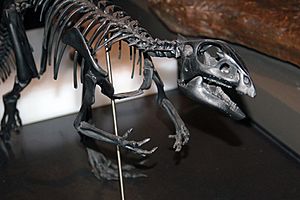Qantassaurus facts for kids
Quick facts for kids Qantassaurus |
|
|---|---|
 |
|
| Skeletal reconstruction of Qantassaurus intrepidus at the Australian Museum, Sydney | |
| Scientific classification | |
| Genus: |
Qantassaurus
|
| Species: |
intrepidus
|
Qantassaurus (pronounced KWAHN-tuh-SOR-uhs) was a type of dinosaur that ate plants. It walked on two legs and lived in Australia about 115 million years ago. Back then, Australia was much further south, even partly inside the Antarctic Circle.
This dinosaur was named by two scientists, Patricia Vickers-Rich and her husband Tom Rich, in 1999. They found its remains near Inverloch. The name Qantassaurus honors Qantas, which is a famous Australian airline.
Contents
What did Qantassaurus look like?
Qantassaurus was likely about 1.8 meters (6 feet) long. It stood about one meter (3 feet) tall. Scientists think it looked similar to its relatives. It probably had short thighs and long lower legs. This would have made it a fast runner.
Its feet had claws to help it grip the ground. A long tail helped it balance and turn quickly. This tail was made stiff by special bones called ossified tendons.
One special feature of dinosaurs from "Polar Victoria" was unique bumps on their thigh bones. These bumps were places where strong muscles attached.
Qantassaurus is mostly known from pieces of its jaw. These jaw pieces show that its face was short and stubby. It had ten teeth in each lower jaw. It probably had a beak at the front of its mouth. Its cheek teeth were shaped like leaves. These teeth would fall out when they wore down. New teeth would then grow in their place. Each tooth had eight clear ridges on the outside. There was one larger ridge in the middle.
Where did Qantassaurus live?
Qantassaurus lived 115 million years ago during the early Cretaceous period. At that time, Australia was part of a huge supercontinent called Gondwana. Part of Australia was inside the Antarctic Circle.
Even though it was near the South Pole, the Earth was much warmer during the Cretaceous period. Scientists are still debating how cold it got. Estimates range from very cold to mild temperatures. It was likely coldest during the polar nights. These nights could last for up to three months.
Some scientists believe that small plant-eating dinosaurs like Qantassaurus had ways to survive the cooler weather. Studies of their bones suggest they were active all year. This means they did not hibernate during winter. The way their bones were built also suggests they were warm-blooded. This would help them keep their body warm.
Qantassaurus was probably a browser. This means it ate plants like ferns. It might have used its hands to grab vegetation. It probably ran away from predators, much like a modern gazelle does today.
How is Qantassaurus classified?
Qantassaurus belongs to a group of dinosaurs called ornithopods. It was first thought to be part of the Hypsilophodontidae family. However, scientists now know that this group is not natural.
More recent studies show that Qantassaurus is a basic type of iguanodont. Some studies even place it in a group called Elasmaria.
Qantassaurus is one of four ornithischian species found in southeast Australia. The others are Leaellynasaura amicagraphica, Atlascopcosaurus loadsi, and Fulgurotherium australe. These dinosaurs are mostly known from single bones and teeth.
How was Qantassaurus discovered?
Qantassaurus was found on February 27, 1996. This happened during a yearly dig called the Dinosaur Dreaming project. This project is run by Monash University and the National Museum of Victoria.
The dig site is on the beach at Flat Rocks, near Inverloch, in southeastern Victoria. The rocks there are part of the Wonthaggi Formation. Millions of years ago, these rocks were formed in floodplains with braided rivers.
The first fossil found was a left lower jaw bone. It was 56 millimeters long and had ten teeth. This important fossil is called the holotype specimen, and its number is NMV P199075. Mrs. Nicole Evered, who often helped with the dig, found it. Two other jaw bones were found at the same site that year. Scientists think these also belong to Qantassaurus.
Patricia Vickers-Rich and Tom Rich named the dinosaur Qantassaurus intrepidus. They chose the name to honor Qantas, the airline. Qantas helped ship dinosaur fossils around Australia. They also sponsored trips to find fossils in other parts of the world. QANTAS is an acronym, which is why there is no 'u' after the 'q' in Qantassaurus. The second part of the name, intrepidus, means "brave" in Latin. This refers to the tough climate the small dinosaur had to live in.
Images for kids
-
Jaw of Qantassaurus intrepidus at the Melbourne Museum
-
Model of Qantassaurus at the Melbourne Museum
See also
 In Spanish: Qantassaurus intrepidus para niños
In Spanish: Qantassaurus intrepidus para niños





